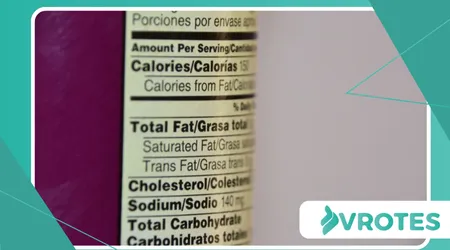How to Read Labels: Avoid Estrogen Disruptors in Processed Foods

How to read labels. Many women face a challenging journey through menopause, often marked by fluctuating hormones.
Anúncios
What if I told you that some of the foods you eat could be making this transition even harder? We’re talking about estrogen disruptors.
These are chemicals that can mimic or interfere with the body’s natural hormones. They lurk in many unexpected places, particularly in highly processed items that fill our grocery store shelves.
Understanding their presence is the first step toward reclaiming your health. Your body is a finely tuned instrument; we must protect its delicate balance.
For women in menopause, hormonal equilibrium is already a precarious state. Adding these disruptors to the mix can amplify symptoms like hot flashes, mood swings, and sleep disturbances.
Anúncios
Our mission here is to empower you with knowledge. You deserve to make informed choices about what you consume.
This isn’t just about avoiding a few bad ingredients; it’s about a lifestyle shift.
What Exactly Are Estrogen Disruptors?
Estrogen disruptors are a broad category of chemicals. They can be synthetic or even naturally occurring, though the synthetic ones are our primary concern here.
These compounds can bind to estrogen receptors, sending confusing signals to your body. Think of it like a faulty key trying to open a lock; it creates chaos.
Some disruptors increase estrogenic activity, while others block it. Both scenarios can be problematic, especially when your hormonal system is already adapting.
Read more: Anti-Inflammatory Spices to Add to Your Daily Diet
They are ubiquitous in our environment, found in plastics, pesticides, and, yes, processed foods. The cumulative effect of exposure is what truly worries experts.
For instance, phthalates and parabens are well-known examples. You might recognize them from personal care products, but they also find their way into food packaging.
The long-term impact of these chemicals on overall health is a growing area of scientific inquiry. We’re seeing more studies linking them to various health issues.
The Problem with Processed Foods
Processed foods, by their very nature, are a Pandora’s Box of ingredients. They are designed for shelf stability, not nutritional density.
They often contain an array of additives, preservatives, artificial flavors, and colors. Many of these are suspect when it comes to hormonal health.
Manufacturers prioritize cost and convenience over purity. This often means using cheaper, synthetic ingredients that extend shelf life.
This convenience comes at a significant cost to your well-being. It’s a trade-off that many consumers unknowingly make every day.
Consider the journey a processed food takes from farm to table. It’s rarely a direct path, involving multiple chemical interventions.
The packaging itself is another major culprit. Plastics, often used for convenience, can leach harmful chemicals into your food, especially when heated.

Decoding the Label: Your Ultimate Guide
Now, let’s get down to brass tacks: how to read labels like a pro. This skill is your best defense against unwanted chemicals.
Don’t be intimidated by the long lists of unpronounceable ingredients. With a little practice, you’ll spot the red flags instantly.
Read here: Hydration Hacks: Drinks to Keep You Cool During Hot Flashes
Your goal is to identify and avoid common culprits that act as estrogen disruptors. It’s easier than you might think once you know what to look for.
The Ingredients List: Where the Truth Lies
The ingredients list is your map. Ingredients are listed in descending order by weight, so the first few items are the most abundant.
Look for short, recognizable ingredient lists. If it reads like a chemistry textbook, put it back.
Prioritize whole, unprocessed foods whenever possible. These have no labels because they are the ingredients themselves.
Be wary of anything that sounds like a chemical experiment. Your body thrives on simplicity, not complexity.
Here’s a crucial tip: familiarize yourself with the common aliases for harmful substances. Manufacturers are clever at hiding them.
| Common Estrogen Disruptor | Aliases/Where to Find It |
| BPA (Bisphenol A) | Often in plastic containers, can linings (look for “BPA-free” but be wary of substitutes) |
| Phthalates | Plastic food packaging (especially flexible plastics), often not explicitly listed on food labels |
| Parabens | Preservatives in some processed foods, often found in baked goods, snacks |
| BHA & BHT (Butylated Hydroxyanisole/Toluene) | Preservatives in cereals, snack foods, chewing gum |
| Red Dye No. 3 (Erythrosine) | Candies, processed foods (linked to thyroid disruption) |
| 4-Methylbenzylidene Camphor (4-MBC) | Sometimes found in packaging materials, not common in food but worth noting |
This table provides a starting point. Research any ingredient you don’t recognize. Knowledge truly is power.

Specific Ingredients to Scrutinize
Let’s break down some specific ingredients you should always question. These are common offenders in the realm of estrogen disruption.
BPA (Bisphenol A): While many products now boast “BPA-free” labels, be cautious. Often, BPA is replaced with BPS or BPF, which can have similar disruptive effects.
++ The Best Low-Impact Workouts to Ease Joint Pain in Menopause
The best approach is to minimize reliance on canned goods and plastic containers. Choose glass or stainless steel whenever possible.
Phthalates: These plasticizers are used to make plastics flexible. They can leach into food from packaging. Unfortunately, they aren’t always listed on food labels.
One way to mitigate exposure is to avoid heating food in plastic containers. Microwaving in plastic is a definite no-go.
Parabens: Commonly used as preservatives in cosmetics, parabens also appear in some processed foods.
Look for methylparaben, propylparaben, and butylparaben on ingredient lists, particularly in items with extended shelf lives. They are known endocrine disruptors.
BHA (Butylated Hydroxyanisole) and BHT (Butylated Hydroxytoluene): These synthetic antioxidants are used to prevent fats from going rancid.
They’re often found in cereals, snack foods, and even some chewing gums. Studies suggest potential endocrine-disrupting activity.
Always opt for products preserved with natural antioxidants like Vitamin E (tocopherols).
Artificial Food Dyes: While not all artificial dyes are direct estrogen disruptors, some, like Red Dye No.
(Erythrosine), have been linked to thyroid disruption, which is closely intertwined with hormonal balance. These dyes offer no nutritional value and are purely cosmetic. Avoid them.
High Fructose Corn Syrup (HFCS): While not a direct estrogen disruptor, HFCS can contribute to insulin resistance and inflammation, both of which can negatively impact hormonal health, especially during menopause. Excess sugar, in general, is detrimental to overall well-being.
The Power of “Organic” and “Non-GMO”
Choosing organic can significantly reduce your exposure to pesticides, many of which are known endocrine disruptors. Organic standards prohibit the use of most synthetic pesticides.
Non-GMO certifications also play a role, as genetically modified crops often involve the use of herbicides like glyphosate, another potential disruptor. Look for these labels as an additional layer of protection.
However, even organic processed foods can contain undesirable additives. Always read the full ingredient list, even on “healthy” products.
It’s an investment in your health, worth every penny. Think of it as preventative medicine.
Beyond the Label: A Holistic Approach
How to read labels is a powerful tool, but it’s part of a larger picture. Your overall lifestyle significantly impacts your hormonal health.
Consider where your food comes from. Locally sourced, fresh produce often has a shorter supply chain and less processing.
Cooking at home gives you complete control over ingredients. It’s a simple yet profound way to reduce exposure to unwanted chemicals.
Minimizing Exposure in Your Home
Your kitchen is your sanctuary. Take steps to minimize endocrine disruptors beyond just food labels.
Store food in glass containers instead of plastic. This is a simple switch that makes a big difference over time.
Use stainless steel or cast iron cookware. Avoid non-stick pans that can release per- and polyfluoroalkyl substances (PFAS) when heated, another class of disruptors.
Filter your tap water. Many water sources contain trace amounts of chemicals that can interfere with hormones.
Be mindful of personal care products and cleaning supplies. Many contain parabens, phthalates, and other chemicals that find their way into your system.
Think of your body’s hormonal system as a finely tuned orchestra. Each hormone is an instrument, playing its part in perfect harmony.
Estrogen disruptors are like rogue musicians who suddenly decide to play off-key, creating dissonance and chaos.
You wouldn’t invite those musicians to your concert, would you? Similarly, we must be vigilant about what we allow into our bodies that disrupts this delicate balance.
A Powerful Statistic
According to the Environmental Working Group (EWG), a non-profit organization, over 70% of canned foods tested in a 2017 study contained BPA.
While efforts have been made to reduce its use, it highlights the pervasive nature of these chemicals in our food supply.
This figure underscores the ongoing challenge of avoiding these substances.
Imagine you’re at the grocery store, looking at two different brands of pre-packaged oatmeal.
Brand A boasts “natural flavors” and “reduced fat,” but a quick glance at the ingredients reveals Red Dye No.
40 and BHT. Brand B, on the other hand, lists only whole rolled oats, dried fruit, and a sprinkle of cinnamon.
Which one would you choose? Brand B, of course. This simple choice, made consistently, adds up to a significant positive impact on your hormonal health.
Another example: You’re craving a snack and pick up a bag of potato chips.
The first brand lists “partially hydrogenated oil,” a source of trans fats that, while not a direct disruptor, contributes to inflammation.
The second brand uses only avocado oil and sea salt. The latter is the clear winner for your health.
Empowering Your Choices
Mastering how to read labels is more than just a dietary preference; it’s a critical aspect of self-care, particularly for women navigating menopause.
By understanding what to look for, you gain control over your exposure to estrogen disruptors.
This journey is about making conscious, informed choices. It’s about prioritizing your long-term health over fleeting convenience.
Remember, every small step you take towards cleaner eating contributes to a healthier, more balanced you. Do you truly know what’s in your food?
Frequently Asked Questions
What are endocrine disruptors?
Endocrine disruptors are chemicals that can interfere with the body’s hormonal system, mimicking or blocking the action of natural hormones.
How do endocrine disruptors affect women in menopause?
During menopause, the hormonal balance is already delicate. Endocrine disruptors can worsen symptoms such as hot flashes, mood swings, and sleep disturbances, making the transition more difficult.
What ingredients should I avoid in processed foods?
Try to avoid BPA, phthalates (indirectly via packaging), parabens, BHA, BHT, and artificial colorings like Red Dye No. 3.
Are organic foods always free of disruptors?
Organic foods significantly reduce exposure to pesticides, many of which are disruptors. However, even processed organic foods can contain unwanted additives, so always read the full label.
What else can I do besides reading labels to reduce exposure?
Use glass or stainless steel containers for food storage, avoid heating food in plastic, filter tap water, and be mindful of the personal care and cleaning products you use.
